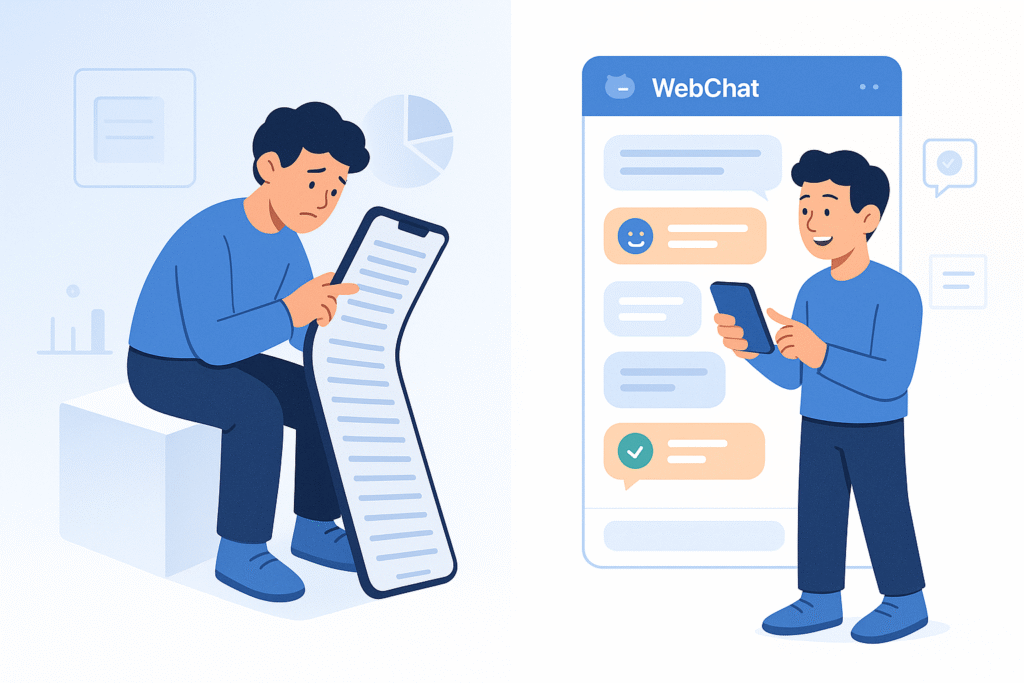WebChat dialog automation has been a trendy topic over the past years. The importance to facilitate better customer support and improve communication have been the primary driving forces of its popularity.
Chats offer a more natural conversation experience on the mobile. We have long been used to exchanging little bits of news via WhatsApp or Messenger. In addition, websites are usually unsuitable for the small screen and result in endless scrolling. This is why you should take into account WebChat dialog automation to enhance the way your brand engages with the audiences.
The future, therefore, lies in WebChat Dialog Automation. Conversational marketing has become one of the best ways to build a bridge with end consumers, automate communication, and improve the overall customer experience.
You may be wondering what the best tips for conversational design are.
Studies have calculated that we scroll an average of 74 meters per day. The level of engagement is correspondingly low – so that, for example, only videos can catch our attention. Therefore, it is high time to rethink the website presentation for mobile users and switch the monologue to a dialogue.
What Are The Tips To Consider in WebChat Dialog Automation?
Here you will find 15 rules and tips to attract, engage and retain your audience with automated communication flows. Follow them to create perfect webchat dialogs that will improve your overall customer experience and result in higher customer satisfaction.
#1 Catch attention
Use the right hook to get your visitor’s attention and let them start a conversation with you. Be involved. The more relevant your contribution to the solution of a task is, the better. Usually, playing helps a lot. Therefore, ask an exciting question or offer a prize.
#2 Primacy Effect
People form an opinion very early on, which is difficult to change in later phases. The first impression counts – it is also true in Conversational UI.
To optimize your webchats, you should emphasize a target group-oriented approach as an introduction to the dialog and briefly explain the bot’s functions and goals to avoid disappointment later.
Hi, I’m Alex, and I’m helping you find your perfect SOLE Mate.
#3 Be brief
Chatbots are mostly used on mobile devices, so keep the messages short. Rule of thumb: take out anything that can be removed without complicating the meaning. Consider using “&” instead of “and”. Remember Antoine de Saint-Exupéry’s famous quote, “Perfection is not achieved when there is nothing more to add, but when there is nothing more to leave out.” Well said and it is particularly true in webchat dialog automation.
#4 Trust
Trust is the basis for using conversational UI. It is especially true in Germany, where Germans are statistically among the most anxious online users. In a Chatbot or Voice Assistant, you should point out outstanding security standards for data transmission and protection, or the security against eavesdropping.
I want to help you simply, quickly, and anonymously. I will not ask you for information that can be used to identify you.
Ensure a certain level of initial trust is achieved, and your users associate initial positive experiences with the technology. In that case, the path is automatically opened for usage in more sensitive areas, such as the use of personal data or payment processing. User trust can be triggered mainly by familiarities, such as the use of already familiar names, images, or avatars, but also by the attractive design, e.g., the chatbot icon.
#5 Always keep your call-to-action (goal) in mind
Always keep in mind why your chatbot exists. What goal(s) does the user try to achieve by engaging with it? How can these goals be reached as quickly as possible? Write down the goals and check whether every sentence you write is necessary and leads to the goals. Enter a value for each step.
The last thing you want is a web chat platform that confuses customers and makes it harder to solve their issues in a timely manner.
#6 Liking
We tend to be convinced more quickly by people we like. You can create sympathy in various ways: similarity, attractiveness, cooperation, and recognition. In conversational UIs, cooperation and recognition are particularly suitable.
Praise your user for his decisions and answers. Make them feel that they are on the right track.
Good choice! You can’t go wrong with our bestseller!
The impression of cooperation can be achieved by setting common goals: “I’m here for you so that you can find your perfect outfit.” In this process, you should adjust the language to your company values and target groups.
#7 Use emoticons a lot
For webchat experiences to be successful, they must be made amusing. It is a proven fact that the usage of emoticons (emojis) leads to much better engagement. Not only can emoticons be used to convey emotions, but they can also help to keep your messages short (see rule #2). So instead of saying “I like it”, just send <3.
Pro Tip: Research emoticons from emojipedia.org, copy, and paste them. Some emoticons look entirely different or even are missing on some platforms, so be careful and do your research first.
#8 Use question marks with caution
Ambiguity is a killer in chat and language experiences. Only ask questions when you really need an answer from your user. If this is not the case, never use a question mark in your texts. Otherwise, people will feel the obligation to answer, and this could mislead them. Rhetorical questions don’t work in webchats!
#9 Offer quick answers
Let’s face it: we, humans, are lazy. For your users, typing answers into a chat interface manually takes some time. However, choosing predefined answers (Facebook calls them “quick answers”) makes things much more straightforward. These quick replies must also be short (maximum 20 characters on Facebook), crystal clear in their meaning, and can also include emoticons. But you already know this.
With these tips in mind, your next webchat automation project should be a piece of the cake.
#10 Small talk technique
In a discussion, do not immediately jump into a serious conversation. You should first kick off with a small talk, which creates familiarity between interlocutors and is a great ice-breaker. Such a communication starter is more natural because a behavioral script is activated and is typically used in dealing with friends.
Hello, I hope you are well and have had a successful day so far!
Your web bot should first thank for contacting it (“Thanks and great to hear from you! ). Also, irrelevant answers to user (“Chit chat”) questions should be available. For instance, if your customer asks: “How is the weather?” You can answer: “The sun is always shining with us!
#11 Use Flattery to Instil Belief (Barnum Effect)
The tendency to relate general and vague statements to one’s own person and to feel deeply understood is called the Barnum Effect. The prerequisite for this is that the formulations are so general that they cannot be refuted. Questions such as “Would you also like to look more fashionable?” or statements such as “For your needs we recommend …” give your user the feeling of a personal, one-to-one approach.
Our new collection is made for you!
Do you use such general formulations in your web chat dialog automation? If not, you definitely should!
#12 Bandwagon Effect
People tend to make decisions not based on rational-functional characteristics but on the popularity of the decision within their peer group. The Bandwagon Effect shows people’s desire to “belong” and get support from others in order to reduce uncertainty.
Our customers love this product – already 100,000 happy buyers!
Phrases such as “Particularly popular with our customers” or “Already 100,000 happy customers” illustrate belonging, create familiarity among users and thus make the purchasing decision easier.
#13 Wheel of Persuasion
Hobson’s Choice is a choice with only one option – eat or die. We use all our mental resources to decide whether or not to buy a product. If an additional option is offered (Hobson’s +1 choice), we use the same amount of mental resources to weigh between options one and two. Accordingly, the option to close the conversational UI, which also means not to buy, receives much less attention.
Good choice! Would you like to…
Buy now
Remember for later
In the conversational UI, additional ready-made selection options relieve the user. Offer them more than one option directly after an open question. In the purchase process, for example, “Buy now” complimented with “Remember for later” or “Register now” together with “Learn more” can be displayed graphically in the chatbot.
#14 Inner Monologue
During the decision-making process, users are in a constant monologue with themselves: they pose concrete questions and think of answers. The positive framing of this dialog is ultimately decisive for the conclusion of a purchase.
More answers to your question:
Where is the item produced?
How do the goods get delivered to me? How can I pay?
Your web bot can specifically address the questions of the inner dialogue to give the most important answers directly and thus ward off possible objections. After an answer, deliver additional content directly and lead your user deeper into the funnel. In the chatbot, you can, for example, present a selection of related questions with the heading “This could also interest you”.
#15 Uncertainty Aversion
Decisions are usually avoided by interested parties if there is a lack of information about the respective decision alternatives. It is not possible to predict what will happen as a result. If your customers do not feel sufficiently informed about your range of services, they switch to alternatives. Your bot is a new communication channel that initially involves a lot of uncertainty.
Hello Jo, my name is Michelle, and I will advise you about your car insurance!
At the beginning of the dialogue, you should actively manage the customer’s expectations – by clearly defining the functional possibilities and the goal of the bot. Ensure the product advice is within a category or if service questions arise, only refer to a particular use case.
Are you ready to take your WebChat Dialog Automation to the next level?
That’s it. These 15 tips will help you build a sophisticated communication channel that will improve your customer experience. Webchat dialog automation is something that has been gaining more and more popularity over the years.
At DiALOGiFY, we help brands bring their webchat dialog automation goals to reality.
Happy dialoguing!










